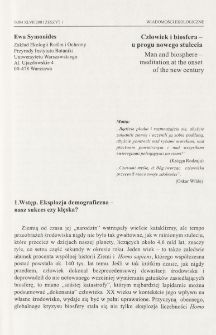- Wyszukaj w całym Repozytorium
- Piśmiennictwo i mapy
- Archeologia
- Baza Młynów
- Nauki przyrodnicze
Wyszukiwanie zaawansowane
Wyszukiwanie zaawansowane
Wyszukiwanie zaawansowane
Wyszukiwanie zaawansowane
Wyszukiwanie zaawansowane

Obiekt
Tytuł: Człowiek i biosfera - u progu nowego stulecia
Inny tytuł:
Człowiek i biosfera ; Man and biosphere - mediation at the onset of the new century
Współtwórca:
Polska Akademia Nauk. Instytut Ekologii
Wydawca:
Oficyna Wydawnicza Instytut Ekologii PAN
Miejsce wydania:
Opis:
Strony 3-31 ; 24 cm ; Bibliografiana stronach 26-30 ; Streszczenie w języku angielskim
Typ obiektu:
Abstrakt:
Life on the Earth, sińce its onset about 3.75 billions years ago, was freąuently disturbed by great cataclysms, but the ratę of environmental changes was never as violent as in the past century and never before such changes were caused by a species living on the Earth. The devastation of natural environment and the modern extinction of many plant and animal species had no precedent in the earlier history of the Earth and it is indubitably caused by humans - the most intelligent mammal species. The common history of Earth and humans counts only about 150 thousands years, and sińce then humans devastated the wildlife and naturę wherever they settled. However, the global environmental crisis took place only recently, in XX century, as the result of demographic explosion of human population.Among the most spectacular humans-caused transformations of natural environment the major are: global deforestation, the overall expansion of the deserts, soil degradation, species extinction or drastic decline of many populations of wild plants, animals, fungi and microorganisms. Human activity on the Earth drove the natural, both terrestrial and aąuatic, ecosystems into almost total extinction. The ozone layer is seriously damaged and global warming of the earth climate became the reality. Both phenomena may herald the sixth great extinction in the history of life on the Earth.The perspective of the global catastrophe urged the governments of nearly all countries to undertake the international cooperation to stop the further degradation and to improve the State of the environment. Last years of the past century brought about many conventions and international agreements aimed to regulate the access to the natural resources and to control their exploitation. The states-signatories are obliged to undertake all possible means to preserve the natural resources for present and futurę needs. First outcomes of this awakening were already visible at the end of the century - in many countries, the emission of green house gases was considerably reduced, the input of pollutants to freshwaters, sees and oceans was lowered, the forests surface increased, the habitats of many endangered species were restituted. These actions, though they do not entirely prevent the further environmentai deterioration. at least slow it considerably down. To save the life on our planet, the profound change of our attitude towards environment is needed - from anthropocentric doctrine considering ourselves as the supreme beings to the creed that representing only one of many species inhabiting the planet, we constitute merely the part of biosphere.
Czasopismo/Seria/cykl:
Tom:
Zeszyt:
Strona pocz.:
Strona końc.:
Szczegółowy typ zasobu:
Identyfikator zasobu:
oai:rcin.org.pl:220820 ; 0013-2969
Źródło:
MiIZ PAN, sygn. P.3259 ; kliknij tutaj, żeby przejść
Język:
Język streszczenia:
Prawa:
Licencja Creative Commons Uznanie autorstwa 3.0 Polska
Zasady wykorzystania:
Zasób chroniony prawem autorskim. [CC BY 3.0 PL] Korzystanie dozwolone zgodnie z licencją Creative Commons Uznanie autorstwa 3.0 Polska, której pełne postanowienia dostępne są pod adresem: ; -
Digitalizacja:
Muzeum i Instytut Zoologii Polskiej Akademii Nauk
Lokalizacja oryginału:
Biblioteka Muzeum i Instytutu Zoologii PAN
Dofinansowane ze środków:
Dostęp:
Kolekcje, do których przypisany jest obiekt:
- Repozytorium Cyfrowe Instytutów Naukowych > Kolekcje Partnerów > Muzeum i Instytut Zoologii PAN > Czasopisma
- Repozytorium Cyfrowe Instytutów Naukowych > Piśmiennictwo > Czasopisma/Artykuły
Data ostatniej modyfikacji:
4 lut 2025
Data dodania obiektu:
26 paź 2021
Liczba pobrań / odtworzeń:
332
Wszystkie dostępne wersje tego obiektu:
https://rcin.org.pl./publication/173194
Wyświetl opis w formacie RDF:
Wyświetl opis w formacie RDFa:
Wyświetl opis w formacie OAI-PMH:
| Nazwa wydania | Data |
|---|---|
| Z. 1. Człowiek i biosfera - u progu nowego stulecia / Symonides E. | 4 lut 2025 |
Obiekty Podobne
Uchmański, Janusz
Sawicki, Ludwik (1893–1972)
Kufel, Lech
Jarzyna, Anita
Bujalska, Gabriela
du Plessis, Gitte

 INSTYTUT ARCHEOLOGII I ETNOLOGII POLSKIEJ AKADEMII NAUK
INSTYTUT ARCHEOLOGII I ETNOLOGII POLSKIEJ AKADEMII NAUK
 INSTYTUT BADAŃ LITERACKICH POLSKIEJ AKADEMII NAUK
INSTYTUT BADAŃ LITERACKICH POLSKIEJ AKADEMII NAUK
 INSTYTUT BADAWCZY LEŚNICTWA
INSTYTUT BADAWCZY LEŚNICTWA
 INSTYTUT BIOLOGII DOŚWIADCZALNEJ IM. MARCELEGO NENCKIEGO POLSKIEJ AKADEMII NAUK
INSTYTUT BIOLOGII DOŚWIADCZALNEJ IM. MARCELEGO NENCKIEGO POLSKIEJ AKADEMII NAUK
 INSTYTUT BIOLOGII SSAKÓW POLSKIEJ AKADEMII NAUK
INSTYTUT BIOLOGII SSAKÓW POLSKIEJ AKADEMII NAUK
 INSTYTUT CHEMII FIZYCZNEJ PAN
INSTYTUT CHEMII FIZYCZNEJ PAN
 INSTYTUT CHEMII ORGANICZNEJ PAN
INSTYTUT CHEMII ORGANICZNEJ PAN
 INSTYTUT FILOZOFII I SOCJOLOGII PAN
INSTYTUT FILOZOFII I SOCJOLOGII PAN
 INSTYTUT GEOGRAFII I PRZESTRZENNEGO ZAGOSPODAROWANIA PAN
INSTYTUT GEOGRAFII I PRZESTRZENNEGO ZAGOSPODAROWANIA PAN
 INSTYTUT HISTORII im. TADEUSZA MANTEUFFLA POLSKIEJ AKADEMII NAUK
INSTYTUT HISTORII im. TADEUSZA MANTEUFFLA POLSKIEJ AKADEMII NAUK
 INSTYTUT JĘZYKA POLSKIEGO POLSKIEJ AKADEMII NAUK
INSTYTUT JĘZYKA POLSKIEGO POLSKIEJ AKADEMII NAUK
 INSTYTUT MATEMATYCZNY PAN
INSTYTUT MATEMATYCZNY PAN
 INSTYTUT MEDYCYNY DOŚWIADCZALNEJ I KLINICZNEJ IM.MIROSŁAWA MOSSAKOWSKIEGO POLSKIEJ AKADEMII NAUK
INSTYTUT MEDYCYNY DOŚWIADCZALNEJ I KLINICZNEJ IM.MIROSŁAWA MOSSAKOWSKIEGO POLSKIEJ AKADEMII NAUK
 INSTYTUT PODSTAWOWYCH PROBLEMÓW TECHNIKI PAN
INSTYTUT PODSTAWOWYCH PROBLEMÓW TECHNIKI PAN
 INSTYTUT SLAWISTYKI PAN
INSTYTUT SLAWISTYKI PAN
 SIEĆ BADAWCZA ŁUKASIEWICZ - INSTYTUT TECHNOLOGII MATERIAŁÓW ELEKTRONICZNYCH
SIEĆ BADAWCZA ŁUKASIEWICZ - INSTYTUT TECHNOLOGII MATERIAŁÓW ELEKTRONICZNYCH
 MUZEUM I INSTYTUT ZOOLOGII POLSKIEJ AKADEMII NAUK
MUZEUM I INSTYTUT ZOOLOGII POLSKIEJ AKADEMII NAUK
 INSTYTUT BADAŃ SYSTEMOWYCH PAN
INSTYTUT BADAŃ SYSTEMOWYCH PAN
 INSTYTUT BOTANIKI IM. WŁADYSŁAWA SZAFERA POLSKIEJ AKADEMII NAUK
INSTYTUT BOTANIKI IM. WŁADYSŁAWA SZAFERA POLSKIEJ AKADEMII NAUK




































